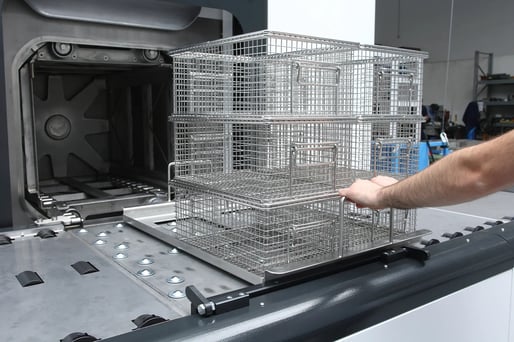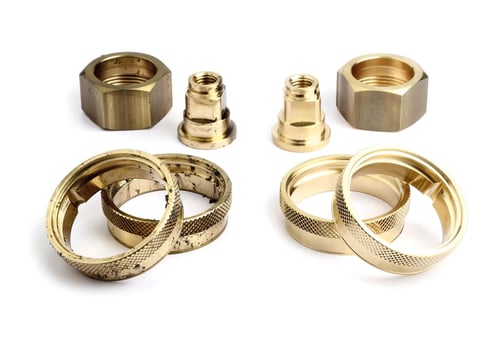The evolution of CNC machining has pushed contemporary manufacturing into new territory. Modern precision machining routinely achieves tolerances of 2-5 microns or less on complex parts, with medical device manufacturers holding tolerances down to 1-3 microns for critical applications. But these remarkable machining capabilities create an equally demanding challenge: how do you clean parts to standards that match their manufacturing precision?

The Contamination Challenge in Precision Machining
CNC operations generate a complex contamination profile that extends well beyond visible chips and coolant residue. Every machining operation leaves behind multiple contaminant layers that can compromise part performance.
Coolant System Residues
Modern CNC coolant systems continuously recirculate fluids through filtration to remove metal particles and debris. However, machined parts must be thoroughly cleaned of contaminants like dust, chips, swarf, oils, and abrasives to ensure proper assembly and product longevity. Water-based and oil-based coolants create emulsified oil films, leave behind metalworking fluid additives including extreme pressure agents and corrosion inhibitors. These residues prove particularly problematic in blind holes, cross-drilled passages, and thread forms where fluid becomes entrapped.
Particulate Contamination
Beyond obvious swarf, precision operations can generate wear particles from cutting tool degradation, abrasive media residue from grinding operations, and metal fines embedded in surface irregularities. In high-precision assemblies, these particles present critical risks.
Ionic Residues
Advanced manufacturing increasingly involves processes that leave ionic contamination (salts from heat treatment atmospheres, chlorides from certain cutting fluids, and sulfur compounds from machining operations). These invisible contaminants accelerate corrosion, interfere with electronic assembly processes, and can compromise weld integrity in critical applications.
Industry Standards
Different industries have established rigorous cleanliness specifications that manufacturers must validate and document.
Automotive Applications
The automotive industry relies heavily on ISO 16232 and VDA 19 standards for technical cleanliness verification. VDA 19.1 and ISO 16232 are central standards for verification of technical cleanliness of components and assemblies, focusing on particulate contamination that can cause serious damage in critical systems. Modern fuel injection systems operating above 2,000 bar with single-digit micron tolerances must meet stringent particulate cleanliness codes. Electric vehicle battery components face equally demanding requirements where any conductive contamination can create leakage paths or thermal hot spots.
Aerospace and Medical Manufacturing
Aerospace fasteners with small diameters and blind holes require vacuum vapor degreasing systems capable of cleaning thousands of parts simultaneously. Medical device manufacturing operates under FDA 21 CFR Part 820 and ISO 13485, establishing cleaning validation requirements that mandate documented, repeatable processes.

Why Conventional Cleaning Falls Short
Traditional spray washing or immersion cleaning methods struggle with the geometric complexity and cleanliness demands of modern precision parts. Parts with internal passages, blind holes, and intersecting features require cleaning methods that can penetrate complex geometries and remove contaminants from inaccessible areas.
Vacuum-based parts washing exploits a fundamental principle: reducing ambient pressure lowers solvent boiling points. Vacuum technology cleans parts faster and more effectively by creating microscopic bubble formation in blind holes and surface irregularities. When atmospheric pressure is restored, these bubbles collapse violently, generating localized shock waves that dislodge particulates and flush contamination from difficult-to-reach areas.
Under vacuum, surface tension effects are minimized, allowing solvents to penetrate fine capillary passages and complex internal geometries, invaluable for Swiss-turned parts with cross-holes, milled components with small coolant passages, or threaded fasteners. Following the cleaning cycle, vacuum evacuation removes solvent without leaving evaporative residue, ensuring consistent drying even for complex assemblies.
Strategic Differentiation Through Cleaning Capability
Many OEM supply chains now require suppliers to demonstrate validated cleaning processes as a qualification criterion. Investment in advanced parts washing technology enables participation in high-value markets while strengthening competitive positioning. Superior cleaning enables tighter assembly tolerances and reduced clearances, cascading to improved product performance — lower leakage in hydraulic systems, reduced friction in precision mechanisms, and better thermal management in electronic assemblies.
Conclusion
As manufacturing tolerances compress and material specifications intensify, parts cleaning has transitioned from afterthought to strategic differentiator. Vacuum parts washing technology offers manufacturers the process capability, efficiency, and validation required for a competitive advantage in precision manufacturing's demanding landscape.
The question isn't whether precision cleaning matters, it's whether manufacturers are ready to treat it as the critical process step it has become.
Ready to discuss your parts cleaning process? Click the button below to chat with an iFP Clean expert about how we can help improve your process.


